Oral Hygiene Advice
Poor oral hygiene can lead to decay and gum disease, and has also been linked to a poor state of general health. Your dentist will be able to give you appropriate oral hygiene advice tailored to your specific needs. It is important to note that regular oral hygiene is the patients’ responsibility. In the case of patients who are unable to care for themselves, oral hygiene is a crucial part of the care they should receive on a regular basis.
Principles of toothbrushing
Regular and careful brushing of the teeth and gums is an important cornerstone of oral hygiene. Thorough brushing does not imply scrubbing the gums very hard, as that might damage them. Rather, it involves careful up-and-down brushing and gently “massaging” the gums when brushing. A manual toothbrush will do the job if used properly but for those amongst us who have a hard time cleaning the teeth or who lack manual dexterity, a recent Cochrane Review suggests that a rotating-oscillating rechargeable electric toothbrush (very important – not a ‘sonic’ brush and not battery-operated) may be of additional help.
Inter-dental cleaning
The spaces between the teeth (the inter-dental spaces) are not reached effectively by the bristles of a toothbrush and therefore require attending to separately. Generally speaking, aids such as floss, super-floss, spiral and interdental brushes are extremely useful in the maintenance of a satisfactory level of oral hygiene.
-

The Electric Toothbrush
Your typical rotating-oscillating rechargeable electric toothbrush. Note the small, round head design.
-
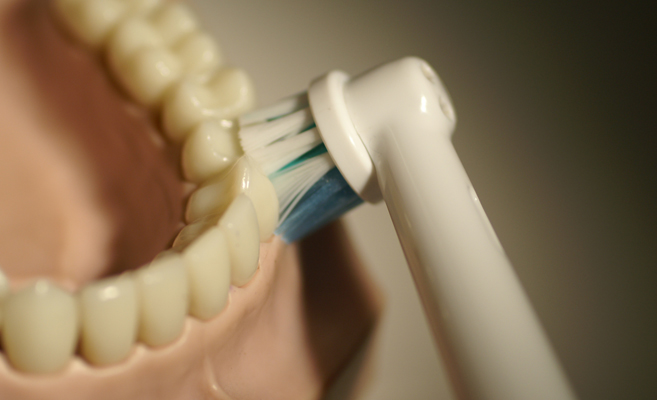
Brushing
You will need to hold the brush head tightly against the teeth, pointing downwards onto the gums. Let the brush do its work for you and gradually move from the left hand side of the mouth to the right in a systematic fashion. Brushing the lower gums (inner and outer surfaces) should take around 30 seconds (with experience).
-
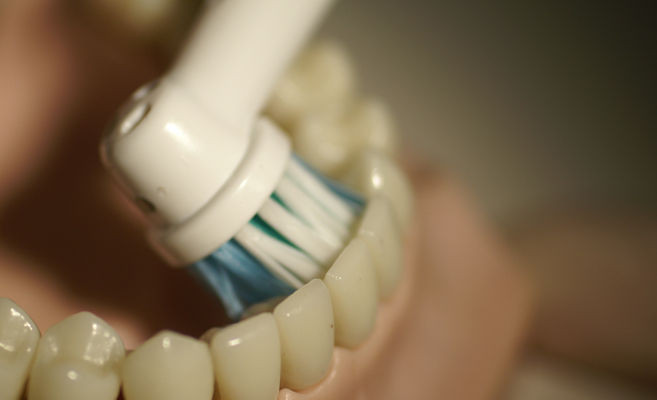
Brushing
After brushing the gums, it will take another 30 seconds to brush the teeth thoroughly this time. You will need to find novel ways of holding the brush to reach areas that are hard to get to.
-
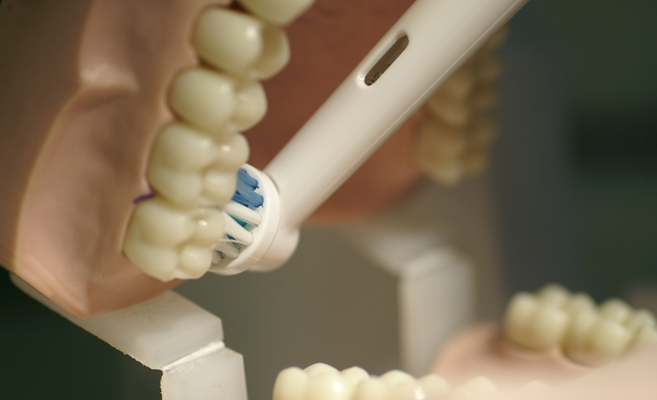
Brushing
The same process is repeated for the top gums and teeth. The whole performance should take about 2 minutes.
-
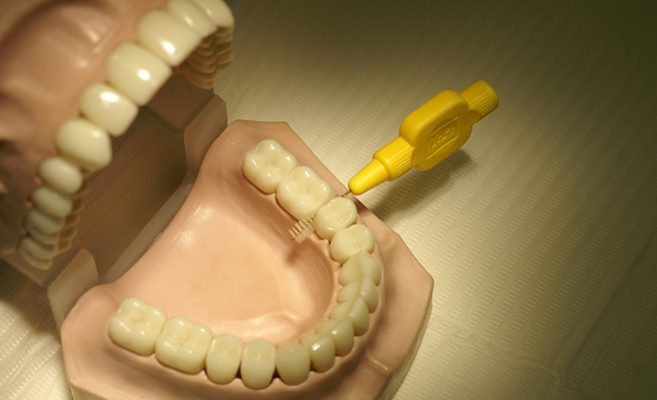
The Spiral Interdental Brush
A spiral interdental brush of an appropriate size is a useful tool in cleaning between teeth with large interdental spaces.
-

Floss-Picks
Floss-picks are extremely useful gadgets that greatly facilitate flossing. Squeezing the limbs of the pick together to tighten the floss, thread it through between the teeth togently slide into the interdental space, then push the floss to the side of one tooth and move down onto the gum as far as you can. Do the same for the interdental surface of the other tooth in the same space.
-

Superfloss
Superfloss helps in keeping the areas underneath bridges clean. It is also useful when crowns have rough margins or where ledges exist under old fillings. First, thread the tough end of the superfloss between the teeth...
-
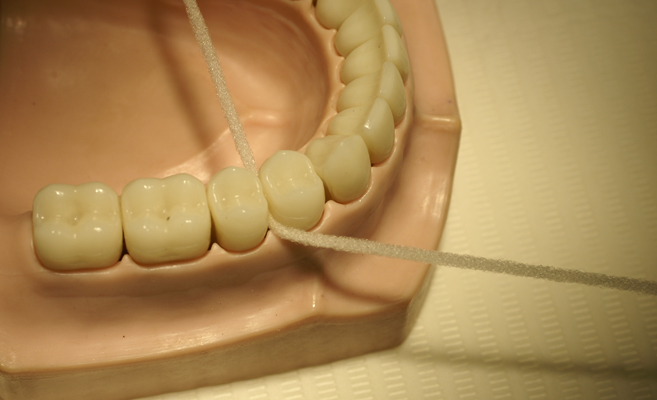
Superfloss
...then pull the spongy bit through and use it to clean the interdental space.
Mental Disabilities
Patients with mental disabilities may be entirely dependent on their carers to maintain a decent level of oral hygiene and thus prevent the onset of dental decay and gum disease. In cases where patients are unable to consent to the carrying out of their personal care, carers should treat patients in their best interests. Failure to do so may constitute wilful neglect of the patients under their care.
Patients who are unable to care for themselves often find their oral hygiene neglected. This can happen for a variety of reasons, including embarassment and lack of awareness on oral health issues. Carers should be alert to signs of potential problems and contact the dental team for an assessment if in any doubt.
Physical Disabilities
Patients with physical disabilities who are still able to maintain a fairly independent lifestyle may find it easier to use an electric toothbrush than an ordinary one; the fairly large handle and the rotating action of the brush head will help achieve a consistent level of oral hygiene. In certain instances, modification of standard brush handles by the application of insulating foam, rubber bands etc may be sufficient to enable the patient to maintain their own oral hygiene. In other cases, patients may depend on their carers to carry out their oral hygiene routine in its entirety or to ‘top-up’ the patients’ own previous efforts. Carers should be aware of the difficulties patients may face and offer to help out with personal care.
-
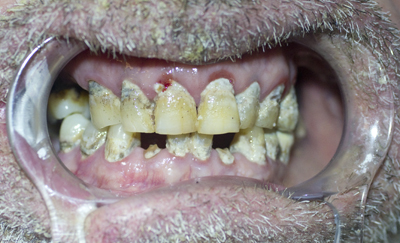
Oral Neglect
Note the thick white deposits of plaque round the teeth, broken teeth and sore, bleeding gums
-
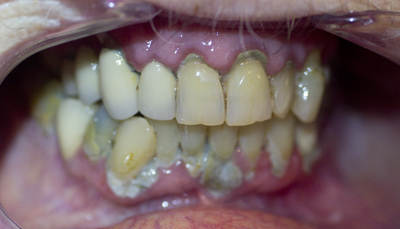
Oral Neglect
Note the gross deposits of calculus (scale) on the teeth and swollen, inflamed gums
-
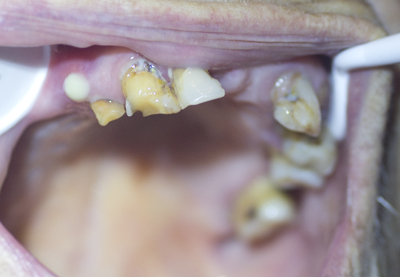
Oral Neglect
Note the broken, decayed teeth and the droplet of pus on the gum, indicating a possible dental infection
Tips To Help Achieve Good Oral Hygiene When Faced With Challenging Behaviour
-
1 .Find a time that is mutually convenient
When your patient is comfortable and at ease and is more likely to comply. Remember that patients are individuals and will respond differently at different times and when faced with different circumstances. Some may respond better to a named carer
-
2. Wear suitable personal protective equipment
(Including gloves, face shield if necessary etc) Get the patient's brush and clean it gently under running hot water to soften the bristles. Apply a smear of toothpaste to the brush. Excess toothpaste is not beneficial, and the excessive foam may make some patients gag
-
3. Inform the patient of each step
in the hygiene process as you go along. Some patients find it easier to comply if they can monitor the process in a face mirror while you approach their mouth from behind. Other patients may find it comforting to have you at eye level at all times, whilst you approach them from the front
-
4. If the process is too tiring
or the patient gets agitated, you may be better off leaving the rest of the hygiene process for a later opportunity. Record your progress for the session and hand it over to the next shift of carers if appropriate, so as to ensure that the full oral hygiene process is completed thoroughy at least once every 24-48 hours
